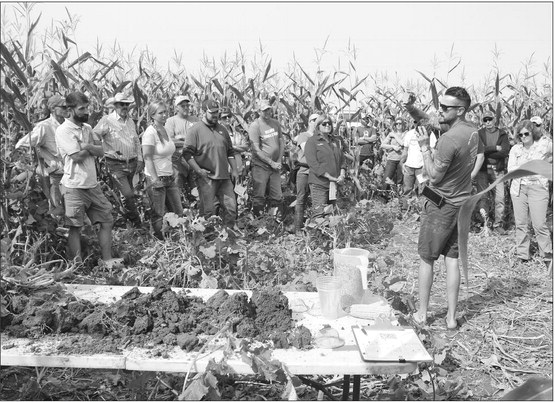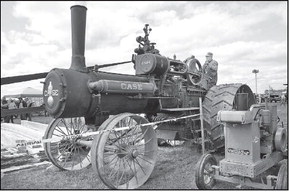Wider corn rows researched


Cover crops hold soil, can be fed to cattle following corn harvest
An experimental corn plot with 60inch wide rows in the town of Hull will likely be just as profitable as corn grown in conventional 30-inch rows, it was reported at an Eau Pleine Partners for Integrated Conservation (EPPC) field day held Thursday.
Matt Oehmichen, a consultant for Short Lane Ag Supply, LLC, Colby, told a gathering of three dozen farmers and ag professionals that corn grown in 60-inch rows interseeded with a cocktail of 11 different cover crops will yield 150 bushel per acre this year. That compares with corn grown in traditional 30-inch rows that will yield 180 bushels per acre in the same field. Oehmichen said corn in the 60-inch rows often generated more corn cobs that were longer and had more kernels.
He said planting the 60-inch rows saved on seed. Bison from Cherokee Bison Farms, Colby, will graze on the cover crops once the corn is harvested this fall. If you plug in a per ton value for the cover crops based on what hay sells for, Oehmichen said the 60-inch corn is just as profitable as the 30-inch alternative.
“It’s pretty much close to a wash,” he said.
Oehmichen reported the fertilizer and herbicide program for both crops were similar.
The consultant said use of the cover crops in the 60-inch row corn improved soil health, which was an advantage over the 30-inch crop.
Oehmichen showed how soil from corn grown in 30-inch rows (“boring old corn”) was blocky and was unable to absorb water whereas the soil with the cover crops was crumbly and moist.
Oehmichen reported that the 30-inch corn rows were planted with 35,000 seeds per acre while the 60-inch rows were planted with half that amount, 17,500 seeds.
Species used in the cover crops included oats, Crimson clover, medium red clover, Dwarf essex rape, Seven Top, Daikon radish, Red Arrow Radish, ARG, cowpeas, buckwheat and Trophy rape brassica.
It was reported that corn growers can go online to find graziers looking for farms where they can have livestock harvest cover crops after corn harvest.

LUSH AND GREEN-Eleven cover crop species were planted in between 60-inch rows of corn. The cover crop protects the soil while the wider corn rows make for longer, fuller corn cobs. The cover crops can be grazed by cattle.

A cob from 60-inch corn row


